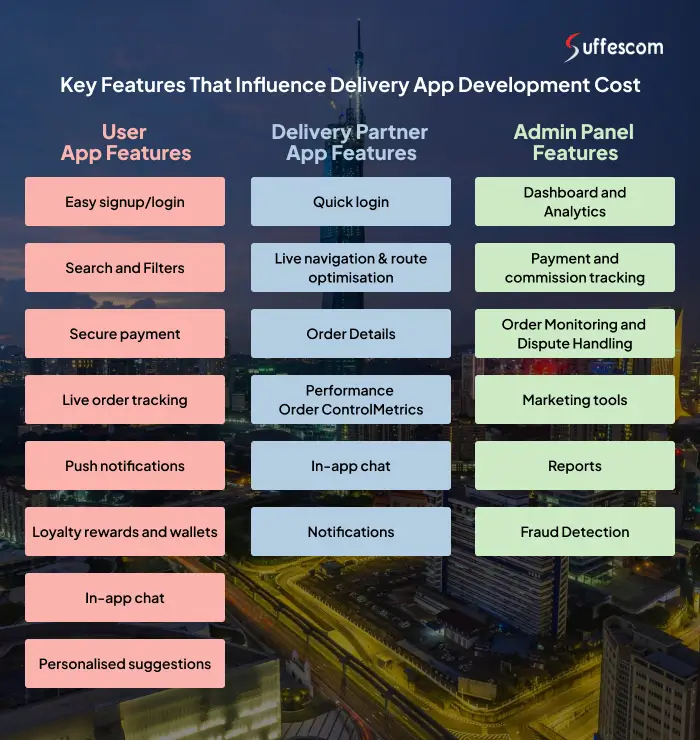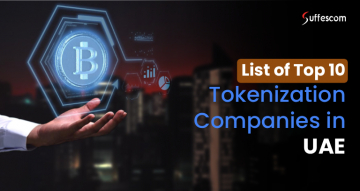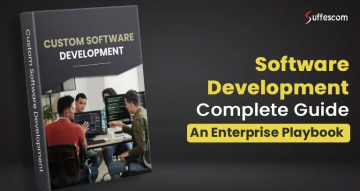Delivery App Development in Saudi Arabia – Cost Guide (2025)

In today’s digital world, Saudi Arabia has grown to be the most attractive market for delivery services. With high mobile usage and a young population, there is a demand for fast doorstep deliveries. From food to groceries, every delivery segment is evolving and expanding with new applications and latest technologies.
According to a report, the last-mile delivery market in Saudi Arabia is expected to reach $11,020.9 million by 2030. This upsurge in delivery app development shows how people choose to order what they require instead of going to the stores. The pandemic has also prompted people to adopt contactless home deliveries and secure payment methods, changing delivery apps into a requirement.
Furthermore, Saudi Arabia's Vision 2030 has quickened this development. Many high investments have been made in smart infrastructure, and a digital economy that makes it easier for businesses to grow and outshine. That's why many startups and businesses are looking to develop a delivery app, but the first question that comes to mind is how much will it cost? In this blog, we will discuss everything about delivery app development cost in Saudi Arabia, its main factors, and much more.
How Much Does It Cost to Develop a Delivery App in Saudi Arabia?
The delivery app development cost in Saudi Arabia requires a clear and precise idea of the budget. The costs can vary based on a lot of aspects, like complexity, the app development partner, technologies utilised, and custom features you want to add. To get a rough overview, knowing the cost range and hidden expenses can help you. So, let's delve into what those are.
Average Cost of Delivery App in 2025
Presently, the average cost for building a delivery app in any segment can range widely. For instance, if you create a simple app with basic functionality, it will cost less compared to an app that is built with advanced features.
Simple Delivery App
It is a basic version where only necessary features like order placements and basic tracking are present, and it can cost somewhere between SAR 60,000 and SAR 120,000.
Mid-Level App
A moderate-level delivery application comes with a better visual appeal, live tracking, and support for vendors. However, it costs between SAR 120,000 and SAR 220,000, which is more expensive than a simple delivery app.
Advanced Level App
An advanced or enterprise-level app with custom features, AI suggestions, multiple language support, and the best security costs between SAR 220,000 and SAR 400,000 or even higher.
Delivery app Development Cost in Saudi Arabia :
| App Type | Estimated Cost Range (SAR) | Timeline |
| Basic Delivery App Development | 60,000 to 120,000 | 2-3 months |
| Mid-Level Delivery App Development | 120,000 to 220,000 | 4-6 months |
| Advanced Delivery App Development | 220,000 to 400,000+ | 6-10 months |
These expenses encompass the development, interface, and testing, but not marketing, maintenance, and compliance.
Cost Breakdown by Team Type
Picking the appropriate app development team directly affects your budget and the quality of the project. Let's explore how expenses are changed with different models.
Local Development Agency in KSA: Contracting with a local mobile app development company in Saudi Arabia guarantees better communication and cultural alignment. The expense would be more than offshore options, but there are many advantages, like local knowledge and better delivery. Keep in mind that the range would be on the upper end.
Offshore Developers: A lot of enterprises like to work with app developers from other countries with low hourly rates. Offshore teams can develop a delivery for any segment at a lower cost, but managing time zone differences and ensuring that the team understands the local market requirements is a significant challenge.
Freelancers: The cheapest and most suitable option for small projects and prototype building is to hire freelancers. But handling multiple freelancers at the same time for all the phases of the delivery app development can consume more time and might affect quality.
Hidden and Recurring Costs to Consider
There are some hidden and recurring expenses besides the upfront app development cost. It is important to budget these expenses as well to make your delivery app better from the start.
Hosting and Server: A delivery app in Saudi Arabia needs to be secure and should have cloud hosting to manage numerous orders and data. Monthly hosting fees vary based on traffic and storage needs.
Third-Party Integrations: Mostly, delivery applications often require payment gateways, map views, or even chatbots to be integrated into the app. These services have usage fees that increase as your user base increases.
Licensing and Compliance Fees: Working and operating legally in KSA may require licensing fees for payment processing and compliance with data protection rules. Include these costs in your app development plan.
Maintenance: To keep the delivery app updated over time, regular maintenance is required, which includes updates with security patches, bug resolutions, and adding new features. Many organisations set aside 15-20% of the total delivery app development cost each year for maintenance services.
Understanding these cost factors from the start will aid you in making better decisions when planning your delivery app cost in Saudi Arabia.
Key Features That Influence Delivery App Development Cost

The features you decide to include in your delivery app play a big role in budgeting the total delivery app development cost in Saudi Arabia. A simple app is more affordable to develop, but it does not have all the features that attract and hold customers. Introducing extra features improves the overall experience, but it requires a larger budget and more time. Let’s discuss the important features for your delivery app.
User App Features
Your users want a smooth and safe experience each time they open the delivery application. Some features that should be present in the user panel side are:
Easy signup/login: Smooth login or sign up with email, mobile number, or Google account.
Search and Filters: The app should have a simple product or service search with filters and sorting.
Secure payment: Options such as cards, wallets, or cash on delivery should be integrated into the app.
Live order tracking: Helps you see where your delivery is in real-time.
Push notifications: They aid in providing information about order status and special offers
Loyalty rewards and wallets: Earn reward points for repeat orders in the app wallet.
In-app chat: Provides customer support for quick help to customers.
Personalised suggestions: Suggest products based on past order history.
Adding more personalisation or AI tools boosts expenses, but helps in keeping customers involved in the delivery app.
Delivery Partner App Features
Drivers and couriers require precise and clear details to complete deliveries within the given timeframe. Some features include:
Quick login: Easy options for logging in to the delivery app through phone number, email, etc.
Live navigation & route optimisation: Helps in getting information in real-time about the fastest routes and traffic.
Order Details: This feature provides details about the pick-up and drop-off locations of users.
Order Control: Option to accept or decline new orders or trips.
Earning & Order History: Helps in viewing overall earnings and order history through a dashboard.
In-app chat: App-chat option with customers or admin support.
Notifications: For new delivery requests and schedule changes, get notified.
A well-designed partner app boosts efficiency and improves delivery accuracy.
Admin Panel Features
The admin panel helps business owners handle every part of the delivery app from one place. It keeps operations smooth. Popular features encompass:
Dashboard and Analytics: This feature helps in monitoring data with key metrics.
Payment and commission tracking: Helps in tracking payouts, transactions, and partner earnings.
Order Monitoring and Dispute Handling: This feature provides tools to help resolve issues and track the status of orders.
Marketing tools: Used for sending push notifications and offers.
Reports: This feature shows reports for revenue, user activity, and delivery times.
Fraud Detection: This feature helps to protect the platform with the best security settings.
Advanced reporting and AI analytics cost more to build but give owners better control over the business.
Custom vs White-Label Delivery App Development Cost

When thinking of developing a delivery app in Saudi Arabia, one decision you have to make is either you want to build a custom solution from the start or a ready-made white-label option. Each option has its benefits and challenges that can affect the overall delivery app development cost and timeline.
What is a Custom Delivery App?
A customizable delivery app is built from the base level according to your needs and requirements. Each and every feature, along with the workflow, is made based on your target audience and conditions.
Benefits of a custom delivery app include:
- Unique design that suits your brand perfectly.
- Flexibility to add or modify features anytime.
- Better control over user experience and data privacy.
- Higher option for future updates and expansions.
The expense of custom delivery app development is higher because it takes longer development time and requires experienced app developers.
What is a White Label Delivery App?
A white label delivery app is an already built solution by a third party. You may have to purchase the license to utilise it and customise its basic functionalities like logo, colours, or content to align with your brand. Core features in white label solutions are pre-loaded.
Benefits of a white label delivery app include:
- Quick launch time because most of the coding part is already done.
- Reduced initial investment in comparison to building from scratch.
- Maintenance and updates are usually managed by the provider.
- Easier to test the market before switching to a custom solution.
However, white label apps have limited flexibility. Adding unique features or integrations might not always be possible.
Cost & Time Comparison: Custom vs White Label Delivery App
| Feature / Item | White Label App | Custom App Development |
| Cost (SAR) | SAR 20,000 – SAR 50,000 | SAR 100,000 – SAR 400,000+ |
| Monthly Maintenance (SAR) | SAR 1,000 – SAR 5,000 | SAR 5,000 – SAR 20,000 |
| Time to Launch | 1 – 4 weeks | 4 – 8 months |
| Design Customization | Limited (Branding, colours, logo only) | Fully customizable (UI/UX from scratch) |
| Scalability | Limited scalability | Highly scalable with tailored architecture |
| Source Code Ownership | Typically not included | Full ownership of source code |
| Features | Standard (Order, Tracking, Payment, Admin) | Custom features (e.g., AI, Analytics, Integrations) |
| 3rd Party Integration | Limited or paid add-ons | Fully integrated as per business needs |
| Backend Control | Minimal or shared | Full admin/backend control |
| Security & Compliance (e.g., SAMA) | Generic may not be fully compliant | Fully compliant with local laws & security |
| App Store Deployment | Done by vendor (branded) | Custom setup and deployment |
This table shows that white label apps cost less and take less time to launch, but custom apps give you full control and long-term value.
When to Choose Which Option
Select white label app if you want to launch in less time and verify your business idea with negligible risk. It works well for startups with limited budgets or businesses wanting to grow in new areas.
Choose a custom delivery app if you want full control over each phase of development and integrated features. Custom apps are ideal for companies that plan to scale, target specific niches, or compete with larger market players.
Tech Stack and Its Cost Impact on Delivery App Development
While budgeting the total delivery app development cost in Saudi Arabia, choosing the right tech stack plays a major role. A well-suited technological stack helps in improving speed and user experience.
Frontend and Backend Tech Used
A competitive delivery app usually has two main elements: the frontend and the backend.
Frontend technologies manage what users see when they open app screens. Popular frontend options for delivery apps are:
- React Native, which allows one codebase to be utilised for both iOS and Android.
- Flutter, which is rising for its speed and attractive UI options.
- Native development using Swift for iOS and Kotlin for Android when you want the best performance.
Backend technologies are those that work behind the scenes that users can’t see, like order processing, payments, and real-time updates. Strong backend choices include:
- Node.js, which is quick and manges a lot of users at the same time.
- Python is utilised because it is flexible and easy to maintain.
- PHP or Java for complex server-side logic.
- Cloud services like AWS or Google Cloud for hosting and storage.
Using newer or multiple frameworks can increase delivery app development costs because it requires experienced developers and more testing.
AI/ML Integration Costs
Many delivery apps in different segments utilise AI and ML to enhance the experience of the user. Artificial Intelligence helps with features like:
- Forecasting delivery times more precisely
- Showing personalised product suggestions
- Spotting fraud or unusual user behaviour
- Automating chat support and order status updates
Integrating extra AI features means extra development time and cost, but it can improve user loyalty and make the app the best among the others.
Choosing Flutter versus Native for iOS and Android
A simple question for startups is if they want to use one cross-platform framework or create separate native apps for each platform.
Flutter is gaining popularity for delivery apps because:
- You build one codebase that is utilised on both iOS and Android.
- Development time is quicker compared to writing code for two separate apps.
- It offers attractive design options that look good on all devices
Native development costs more but sometimes delivers better performance and smoother user experiences, especially if your app handles heavy real-time tracking or maps. Startups with limited budgets often choose Flutter or React Native to launch quickly. Established businesses may invest in native apps to achieve the highest quality and performance.
Want to know the exact cost for your delivery app idea?
Timeline to Build a Delivery App
Designing a timeline of the process of the app will also assist you in scheduling the launch, promotion, and financial aspects of the plan. Usually, the duration is dependent on numerous factors such as the complexity of the application, the number of features, and so on. The approximate estimate that the majority of the enterprises in Saudi Arabia may anticipate is given below:
Design Phase
This phase takes about 2-4 weeks. In this timeline, app designers develop the application's view, which includes wireframes and user interface design. An app that is designed well makes it easy to operate and keeps users coming back. Key sections in this phase include:
- Identifying customer choices and competitors
- Developing unique wireframes and prototypes
- Finalising colours, fonts, and brand elements
- Obtaining feedback and making improvements
Development Phase
The longest and most important phase is where actual app development takes place, typically taking about 8-16 weeks. This timeline can also vary according to the features incorporated and the type of approach. Key tasks in this phase include:
- Writing clean code for the frontend and backend
- Integrating payment gateways and map services
- Building user, partner, and admin panels
- Connecting APIs for notifications and third-party tools
- Conducting internal tests during app development to identify early bugs
Testing and Launch
On average, about 2-4 weeks are taken by the testing and launch phase, where everything is unplanned to check if everything is working as planned, and bugs are solved if found. Testing and Launch involve:
- Checking the app on different devices and screen sizes
- Resolving bugs and glitches
- Running security checks to protect user data
- Preparing app store listings and submitting to Apple and Google for approval
Total Timeline Estimate
A complete delivery app development project in Saudi Arabia takes three to six months from the first vision to the official launch. Apps with more custom features or advanced technology may require additional time for development and testing.
Planning a realistic timeline helps keep your project on track and enables you to enter the market at the right moment.
Industry-Specific Cost Scenarios
Different types of delivery apps serve in different industries, which have their own requirements, and this can also influence the overall app development cost. Some sectors might need more security, while others might need other features. Understanding what to expect for your specific industry helps you budget precisely.
Grocery Delivery App
Developing a grocery delivery app costs more than a basic food delivery app due to its required functionalities, such as product categorisation, inventory updates, and choices for scheduling deliveries. You can also incorporate loyalty points or deals for repeat orders from users.
Typical budget: Mid to high range, depending on complexity and product volume.
Pharmacy and Medicine Delivery App
Pharmacy delivery apps must follow strict rules for handling prescriptions and sensitive health information. They usually require user validation, verified payment systems, and direct tracking of orders. Some apps also include online chat with a pharmacist or doctor. The development cost increases because of these compliance requirements.
Typical budget: Mid to high range with additional cost for secure data handling.
Food and Restaurant Delivery App
Online food delivery apps are prevalent in Saudi Arabia, with their market size anticipated to rise up to $1.39 trillion in 2025. Many of these apps offer standard functionalities, including listing restaurants, browsing menus, and user ratings. You can also consider adding more features such as live chat, tipping, or AI-based suggestions.
Typical budget: Low to mid-range if using basic features, higher for unique design and AI personalisation.
Courier and Last Mile Apps
Courier and last-mile delivery apps focus on moving packages quickly within cities. They tend to have various features, pick up and deliver products, real-time driver monitoring, and proof of delivery security. Advanced route optimisation or fleet management tools can be added, and these usually cost more.
Typical budget: Mid-range, higher if fleet tracking and route optimisation are included.
Logistics and E-commerce Delivery
Massive logistics and e-commerce delivery apps usually require complicated systems that can run warehouse management, payment tracking across cities, as well as support various delivery partners. Such apps typically demand a profound backend connection with e-commerce websites and payment systems.
Typical budget: High range due to complex workflows and backend systems.
Knowing these industry-specific factors helps you to establish the right budget and select the best features for your delivery app project in Saudi Arabia.
Business Models and Revenue Strategy For Delivery Apps
A strong revenue plan is just as important as building a delivery app. Knowing how your app will generate income helps you pick the best business model and plan for steady growth. Most delivery apps in Saudi Arabia follow one or more of these proven revenue methods.
Commission-Based Model
This is the most common way delivery apps earn money. The app charges restaurants, stores, or service providers a commission on each order placed through the platform. This creates steady income as the number of orders increases. Key points include:
- Commission rates can change by product type or order value.
- Appropriate for food, grocery, and pharmacy deliveries.
- Encourages partners to join and reach more customers without high marketing costs.
Subscription or Partnership Models
Some delivery services request a fixed monthly or annual fee from their business partners rather than taking a per-order commission. This model generates a fixed revenue, and it is favored by courier and last-mile delivery apps. Key points include:
- Fixed fees mean steady cash flow for the app owner.
- Partners enjoy unlimited transactions without extra fees.
- Often paired with premium support and promotional tools.
Ads and Promotions
Showing advertisements within the app is also an option in order to raise additional revenues. Restaurants, stores, or brands pay to advertise their offers as banners, sponsored listings, or special deals to get more users. Key points include:
- Increases partners’ visibility without extra marketing effort.
- Works well alongside other revenue streams.
- Keeps the app free for users while boosting income.
Delivery Charges and Service Fees
Some delivery applications take a small fee from users for each delivery or add a service fee to the order total. This fee covers operational costs and adds an extra income stream directly from customers. Key points include:
- Clear service fees build user trust.
- Flexible pricing based on distance, time, or delivery speed.
- Common in food delivery and same-day courier apps.
Franchise or Licensing Model
Some successful delivery companies expand through offering franchising or providing licenses. This enables local entrepreneurs to use the established technology, while the brand will pay an Initial fee and a royalty fee. Key points include:
- Expands the brand without high direct operating costs.
- Generates income from franchise fees and ongoing royalties.
- Popular for scaling to new cities or countries.
Government Regulations & Compliance For Delivery App Development
Following local rules is a requirement for any delivery app that wants to work legally and create customer trust in Saudi Arabia. Data security permissions, payment permission, language requirements, and industry-specific permissions are also important. Staying compliant safeguards your business from fines and penalties and helps you maintain a good reputation.
Data Protection Laws
Saudi Arabia also has clear data protection regulations regarding user information and privacy. It should involve high-quality encryption, secure servers, and a precise privacy policy. You will also have to adhere to international regulations such as the General Data Protection Regulation, in case you deal with international data.
Payment Gateway Licensing (SAMA)
To process online payments, delivery apps in Saudi Arabia must use accepted payment gateways regulated by the Saudi Arabian Monetary Authority. This will provide surety that any business done obeys the laws of local banks and safeguards the capital of the customers.
Arabic Language & RTL Compliance
Applications should have the Arabic language and a right-to-left layout as per local users' preferences. This is more than a legal requirement because it is important for user satisfaction and higher adoption rates. Do proper testing to guarantee a smooth user experience in both Arabic and English, if offered.
Why Work with a Saudi-Based App Development Company?
There are numerous advantages of choosing a local app development partner, particularly in the case of a delivery app whose target customers are in Saudi Arabia. Local companies are more familiar with the market than offshore teams. This leads to quicker delivery and a successful delivery application in any segment.
Cultural Compatibility & Local UX
The users have expectations in terms of design, service flow, and language, and a local app development company based in Saudi Arabia is aware of the same. This ensures your app feels familiar and easy to use.
- Local designers know Arabic language nuances and cultural preferences.
- Better alignment with Saudi social habits and service expectations.
- Higher customer satisfaction due to culturally tailored interfaces.
Faster Turnaround and Time Zone Alignment
When the time zone of the team is the same as yours, communication is quicker, and problems are solved faster. It minimizes delays that are likely to arise compared to when offshore teams are developing the application.
- Faster feedback loops and progress updates.
- Easy scheduling for meetings and project reviews.
- Shorter development time compared to coordinating with distant teams.
Compliance and Localization Expertise
Saudi-based companies are familiar with local regulations and industry standards. They help you stay compliant with data privacy, payment processing, and Arabic language rules.
- Deep knowledge of local data security laws.
- Approved payment gateway integration.
- Full support for Arabic and right-to-left interfaces.
Partnering with a trusted Saudi development company gives your delivery app the local edge needed to compete and grow successfully in the Kingdom.
Final Thoughts – Is 2025 the Right Time to Invest in a Delivery App?
Saudi Arabia’s delivery market is expected to continue growing in 2025, primarily because of a young population, government support, and high demand for services that can provide comfort and convenience.
Investing in a delivery app development service now allows you to take advantage of this expanding market before competition becomes even tougher. Appropriate business model, solid functionality, and thorough adherence to the local regulations are possible ways that will help your app make a mark in the market.
Working with an experienced app development company in Saudi Arabia like Suffescom makes it easier to build an app that covers local expectations and launches quickly. From food delivery to courier services, there is high potential for businesses wanting to offer reliable and user-friendly solutions.
If you plan carefully and understand the true cost and time needed, 2025 is a promising year to turn your delivery app idea into a successful business in the Kingdom.
Planning to Launch Your Delivery App in 2025? Connect With Us Now.
FAQs
How much does it cost to build a delivery app in Saudi Arabia?
Delivery App Development Cost in Saudi Arabia can be categorized into three levels, which are:
- Basic apps: SAR 60K–120K
- Mid-tier apps: SAR 120K–220K
- Enterprise apps: SAR 220K–400K+
What factors affect the cost of delivery app development?
The factors that affect the cost of delivery app development are:
- App complexity & features
- Development team location
- Backend infrastructure
- Compliance & localization
How long does it take to develop a delivery app in Saudi Arabia?
The time taken to develop a delivery app is divided into three sections based on your needs:
- On average: 3 to 6 months
- Basic MVPs: 2–3 months
- Advanced apps: 6+ months
What delivery apps are trending in Saudi Arabia?
The delivery apps that are trending in Saudi Arabia are:
- HungerStation
- Mrsool
- Jahez
- Nana
- Talabat
Can I integrate AI in a delivery app in KSA?
Yes, you can integrate AI in a delivery app, which can automate the following:
- Route planning
- Order prediction
- Customer support
What's the ROI of launching a delivery app in Saudi Arabia?
The ROI of launching a delivery app in Saudi Arabia is high due to:
- 90% smartphone penetration
- Rising demand for convenience
- Growing e-commerce sector
What are the best payment gateways for Saudi apps?
The best payment gateways for Saudi apps include:
- STC Pay
- Tap
- HyperPay
- Mada
- Apple Pay
Do I need Arabic & English in my delivery app in KSA?
Yes, you need dual-language support (Arabic & English) for the delivery app in KSA, as RTL layout is mandatory for Arabic UX.
Can I hire app development companies locally in Saudi Arabia?
Of course, you can connect with a lot of companies in Riyadh, Jeddah, Khobar that offer:
- End-to-end app development
- Local support & maintenance
What’s the best tech stack for delivery apps in 2025?
The best tech stack for delivery apps in 2025 is:
- Flutter (cross-platform)
- Node.js, Firebase backend
- MongoDB or PostgreSQL
- Google Maps API, Twilio
Should I launch on Android or iOS first in Saudi Arabia?
Yes, but first Android due to a larger market share than iOS, as it is preferred in urban areas.
Is a white-label delivery app cheaper than a custom app?
Yes, the cost of white-label apps is 30-50 percent cheaper and is quicker to launch, but they come with limited customization.







